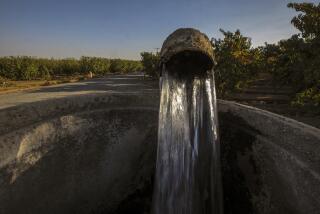Save the Bay--and the Lagoon
- Share via
As the rain begins to fall in Los Angeles, carrying with it billions of gallons of polluted and untreated urban runoff into our coastal waters, this is a good time to remember the significance of the Clean Water Act, which marks its 25th anniversary this year.
Enacted during a time when some of the nation’s waters were so polluted they literally caught fire, the act set high standards to ensure that our waters would again become “fishable and swimmable.”
The goal of the act was to reduce pollution discharge until it was ultimately eliminated by 1985. Plainly, that goal has not been met, although we have made significant progress. The dumping of untreated sewage in rivers has decreased by 90%; more rivers, lakes and estuaries are safer for swimming and fishing; and by some estimates more than a billion pounds of toxic pollutants are kept out of surface waters every year by the act’s restrictions.
Unfortunately, the Los Angeles region and, in particular, Santa Monica Bay, have not benefited as much as they should have from the Clean Water Act. The bay continues to be officially listed as an “impaired” water body by the Los Angeles Regional Water Quality Control Board, the state agency charged with implementing the Clean Water Act locally.
Some of the most famous beaches in the world are still fouled by pathogens that have been demonstrated to make many swimmers sick; urban runoff and storm water pollution continue to sweep a toxic soup of contaminants and human pathogens into our coastal waters year-round, but especially during storms. Recent studies claim that some fish caught off the coast, such as the white croaker, are so contaminated with pollutants that they are unfit for regular consumption.
All told, more than 100 bodies of water or segments are impaired and degraded in Los Angeles and Ventura counties. By any measure, a host of serious water quality and public health problems remain.
The blame for these persisting problems lays not so much with the Clean Water Act, but with the Regional Water Quality Control Board’s failure to properly and fully implement the law.
The appointed board simply has failed to adequately regulate water pollution and has neglected basic aspects of the Clean Water Act. For example, the act required by 1977 that “total maximum daily loads” of pollutants be established for impaired bodies of water, such as Santa Monica Bay and Malibu Lagoon. Yet, 20 years later, the regional board has not implemented this bedrock component of the law. Similarly, pollution discharge permits are often proposed that do not contain meaningful limitations on the pollutants causing the most problems.
One of the regional board’s most fundamental mistakes has been allowing its “watershed management initiative,” designed to analyze water pollution problems holistically, to undercut Clean Water Act implementation. While laudable in concept, the devolution of this initiative has created lengthy permit free-for-alls, where polluters negotiate and sometimes virtually write their own Clean Water Act discharge permit. Good science and national standards are at times ignored by regulators; compromise for the sake of compromise mistakenly becomes the guiding principle.
The leading example of the failure of this approach to Clean Water Act implementation is the 1996 municipal storm-water permit, which would require cities to reduce the largest source of pollution to Santa Monica Bay. Billions of gallons of urban runoff and storm water pollution flowing from city streets, industries and other sources directly to the ocean during rainstorms.
After more than a year of delay, occasioned by hundreds of meetings designed to achieve compromise and “buy-in” by the regulated parties, the board in 1996 finally issued what was heralded as a landmark consensus permit. The only problem was that the “consensus” was immediately challenged in court by one recalcitrant city, Long Beach, and indirectly challenged by other local governments, many of whom have dragged their feet in implementing critical permit requirements despite compromises made to win their support.
If the effects of El Nino are as predicted, this could be an epic year for storm water pollution. But ultimately, storm runoff is only one of the regional board’s pressing problems--just one aspect of the Clean Water Act that remains unfulfilled in Southern California.
The regional board needs to cease its endless discussion with polluters and start to deliver the results that the Clean Water Act was designed to achieve: clean water.
More to Read
Sign up for Essential California
The most important California stories and recommendations in your inbox every morning.
You may occasionally receive promotional content from the Los Angeles Times.










